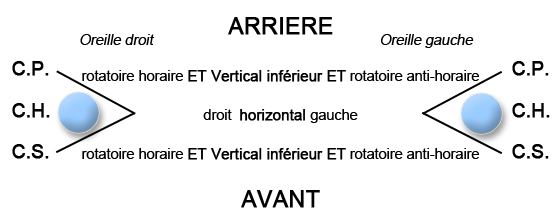Search for spontaneous nystagmus or eccentric gaze relay (Evaluation)
Following verification of technical requirements (and videography calibration), this is the first stage of the protocol with graphic recording.
It is first carried out in the medial gaze. Remember the importance of the absolute immobility of the head. The direction and frequency of the potential nystagmus will be carefully noted. Conventionally, the direction of the nystagmus is given as the direction of the rapid saccadic eye movement.
Remember that in the table below, the connections of the semi-circular canals with the extraocular musculature. This allows us to understand (see the following table) the ocular responses given by the isolated stimulation of each semicircular canal.
Correlation between semi-circular canals with respect to the eye muscles (Baloh and Honrubia)
Nystagmus can be observed through the isolated stimulation of the canals (Leigh & Zee)

The potential modification of the nystagmus by switching on a visible light in front of the subject and any fixation will be carefully noted.
Remember that traditionally, the peripheral nystagmus is greatly inhibited during fixation. It does not, (or scarcely) change as it is caused centrally, stemming from a disorder of the brain stem or cerebellum.
We advise the practitioner to register their results on a classic Frenzel diagram. This results in a quicker view of the intensity of the nystagmus (when it is unidirectional) in keeping with the classic Alexander’s Law.
Alexander’s Law: the degree of intensity of a horizontal left-beating nystagmus

Then we deal with eccentric gaze. The nystagmus that is eventually observed under these conditions is called a "gaze-nystagmus".
Remember that the ocular deviation should not be greater than 30° (as a simple benchmark, the practitioner should not let the internal edge of the Iris of the opposite eye reach the caroncula). In fact, if it surpasses this angle, the movements that will eventually be observed reflect the coming into play of the proprioception of the eye muscles. They are therefore physiological in nature.
If the examination protocols are followed, the nystagmus is a sign, as a rule, of a central disorder, even more so if it is bidirectional (a right-beating nystagmus when looking to the right, and a left-beating nystagmus when looking to the left).
Remember, in this test, the localising value of the “down-beat nystagmus" strongly evokes a disorder of the inferior part of the brain stem (Arnold Chiari malformation in particular).





